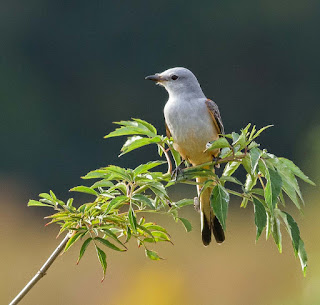 |
| *Scissor-tailed flycatcher- photo (Oct 2013) courtesy Sharon Milligan For more articles click on blue title For this week's field trip, go to the end of the article |
It happens every year, but somehow I never tire of the
changes in birdlife that come about in October. In the course of a few days, we
seem to switch gears from focusing on transient species headed south, to the daily
arrivals of birds that will remain with us for the winter.
Common as some of them are, the winter birds in their
mostly-modest cold-weather plumage are every bit as exciting as the dazzling
Magnolia Warblers and Scarlet Tanagers to which we turned our attention early
in the month.
Now the woods are charged with the drummings of woodpeckers,
the whinings of sapsuckers, the name-callings of Eastern Phoebes, the scoldings
of House Wrens, the chatters of Ruby-crowned Kinglets, the lisps of
Golden-crowned Kinglets, the clucks of Hermit Thrushes, the arguments of
Solitary Vireos, the ticks of Yellow-rumped Warblers, the ringings of Swamp
Sparrows and the yelpings of Song Sparrows.
Now the air space above lakes and marshes is dominated by
Tree Swallows, their snow-white underparts a take-to-the-bank field mark, and
the thermals are claimed by Red-tailed hawks and Northern Harriers. Now the
beaches have been returned to a motley group of gulls and terns and shorebirds.
Now the wintering rails have invaded the marshes and fields.
Now the utility wires are lined with starlings, not martins,
and the open perches are crowned with kingfishers and kestrels. Now the
beachfront pilings are owned by Double-crested Cormorants, Brown Pelicans and
Great Blue Herons.
Offshore, ducks race past, too fast and too far for
identification, and loose formations of White Pelicans, ibises and geese make
the sky busy.
Soon the quiet ponds and lagoons will support a colorful
mélange of dabbling ducks, and the waters of the Mississippi Sound will host
the loons, the Horned Grebes, the Red-heads, the Canvasbacks, the scaups (both
of them), the Buffleheads, the Red-breasted Mergansers and the Common
Goldeneyes.
Way out, near the islands, scoters and oldsquaws will be
there for those who find the Sound and the Gulf at their best in winter, and
Northern Gannets will join our Brown Pelicans in
high-diving exhibitions.
For now, we are in a period of transition when a day in the field can net both an
Eastern Wood-Pewee (a summer resident) and an Eastern Phoebe (a winter
resident) and perhaps, for the lucky, a Western Kingbird, or a *Scissor-tailed
Flycatcher, and maybe even a Vermilion Flycatcher.
It is the time of year when we may hear the yank-yank-yank
of a Red-breasted Nuthatch above the rubber-duck squeakings of a multitude of
Brown-headeds, or fuss-up a Grasshopper Sparrow amidst a full complement of
Savannahs.
It’s the right time to remember that the Ruby-throated
Hummingbird is the RARE one in winter, and the hummer at your feeder could be a
Rufous, a Black-chinned, or something even more illustrious here in the east. Editor's note: Nine western hummingbirds have been recorded on the MS coast at time of writing (2016). Four of them, Black-chinned, Rufous, Calliope and Buff-breasted occur virtually annually, sometimes in multiple numbers. The other five (Allen's. Anna's, Broad-tailed, Broad-billed and White-eared) are rare to accidental.
The time is right for a Groove-billed Ani, a White-winged
Dove, a Black-headed Grosbeak, a White-crowned or Clay-colored sparrow, a Green-tailed
Towhee. a Yellow-headed Blackbird.
More than 280 species have been recorded here on the coast
in October, and more than 270 in November, making these two months among the most
productive of them all. Get in on the euphoria. Go birding!
This article was published in October, 1988
This article was published in October, 1988
Mississippi Coast Audubon Society field trip - all are welcome!
Saturday, October 29, 2016: Hiller Park near Biloxi Back Bay, Harrison County.
Leader: Dave Reed vickianddave1@gmail.com
Look for late migrants at some of the local parks in the area. We will start at Hiller Park on Biloxi Back Bay followed by Popp's Ferry Causeway Park and James Hill Boardwalk. This is an easy-walking tour with some nice camera opportunities in a variety of habitats.
Place and Time: Meet at the Hiller Park Tennis Courts (MAP) at 7:30 AM.
__._,_.___



